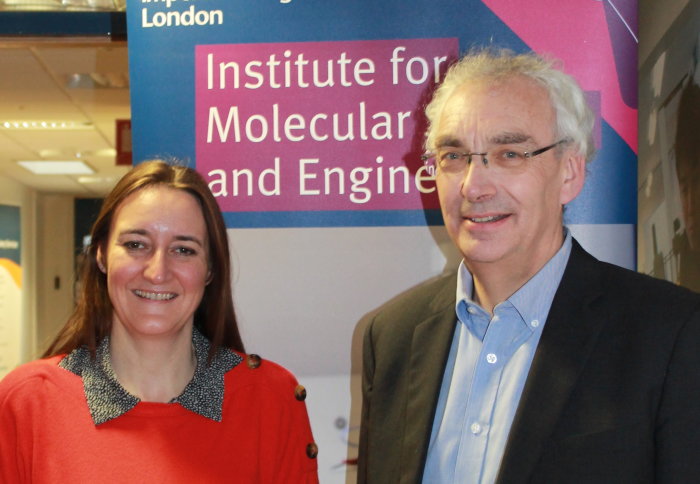From the atom to the material

Professor Mike Payne (University of Cambridge) with IMSE Co-Director Claire Adjiman.
The capabilities, strengths and weaknesses of existing atomistic modelling methods were explored in this week's IMSE Highlight Seminar.
The recent Highlight Seminar from the Institute for Molecular Science and Engineering (IMSE) discussed ‘From the atom to the material’, one of the buzz phrases currently in fashion in condensed matter physics. It was given by Professor Mike Payne, chair of Computational Physics in the University of Cambridge.
Reducing the time for materials to get to market
Advanced materials, materials that have superior performance in one or more characteristics, have applications in addressing grand challenges such as clean energy, computing, and human welfare. Yet it can take 20 or more years to move a material after initial discovery to the market. Accelerating the pace of discovery and deployment of advanced material systems is therefore important to achieving global competitiveness in the 21st century.
Such initiatives such as The Materials Genome Initiative and the European Materials Modelling Council have been established in an effort to discover, manufacture, and deploy advanced materials faster and cheaper. in fact, since the launch of Materials Genome Initiative in 2011, the United States Federal government has invested over $250 million in new R&D and innovation infrastructure to anchor the use of advanced materials in existing and emerging industrial sectors in the United States, and there are many calls from industry for such capability.
Modelling alone has yet to show results
Whilst modellers may claim that their work fulfils the objective of delivering materials substantially faster and cheaper, it is not clear that any materials discovered using modelling alone have reached market. Professor Mike Payne Chair of Computational Physics in the University of Cambridge
In his talk, Professor Payne was not optimistic about the use of modelling alone to create this new breed of advanced material, claiming that it is still not clear that any materials discovered using modelling alone have reached market. Indeed he went further to warn the community to beware predictions made of yet to produced "fantasy" materials. The reason why modelling alone has struggled to design new materials, despite the equations that characterise materials being deceptively simple, is due to the vast computing power needed to model a small number of electrons accurately.
Professor Payne did however cite two successful modelling assisted materials development projects. The first was The Ford Motor Company who have successfully used quantum mechanical modelling to reduce the design cycle of a new engine. Another example was Intel; in a bid to maintain Moors Law, the company has been researching other materials than silicon to boost computing performance. However Professor Payne observed that to enhance computing power further, silicon needs only solve one problem, whilst other materials have many more.
From the successful examples, it has led Professor Payne to conclude that only when you bring atomistic modelling into entire design network will it bring success, and that successful projects have been able to connect real world challenges to atomistic simulations.
Biography
Professor Mike Payne holds the Chair of Computational Physics in the University of Cambridge. He has worked on quantum mechanical total energy calculations since 1985, is the author of the first principles total energy pseudopotential code CASTEP and has been involved in the development of the linear scaling code ONETEP and the LOTF (Learn-On-The-Fly) hybrid modelling scheme. He has published more than 280 papers which have had over 30,000 citations. He was elected a Fellow of the Royal Society in 2008, Honorary Fellow of the Institute of Physics in 2011 and awarded the 2014 Swan Medal by the Institute of Physics. CASTEP and ONETEP are both sold commercially by Biovia and CASTEP has cumulative sales exceeding $40 million.
Article text (excluding photos or graphics) © Imperial College London.
Photos and graphics subject to third party copyright used with permission or © Imperial College London.
Reporter
Dr Kieran Brophy
Faculty of Engineering